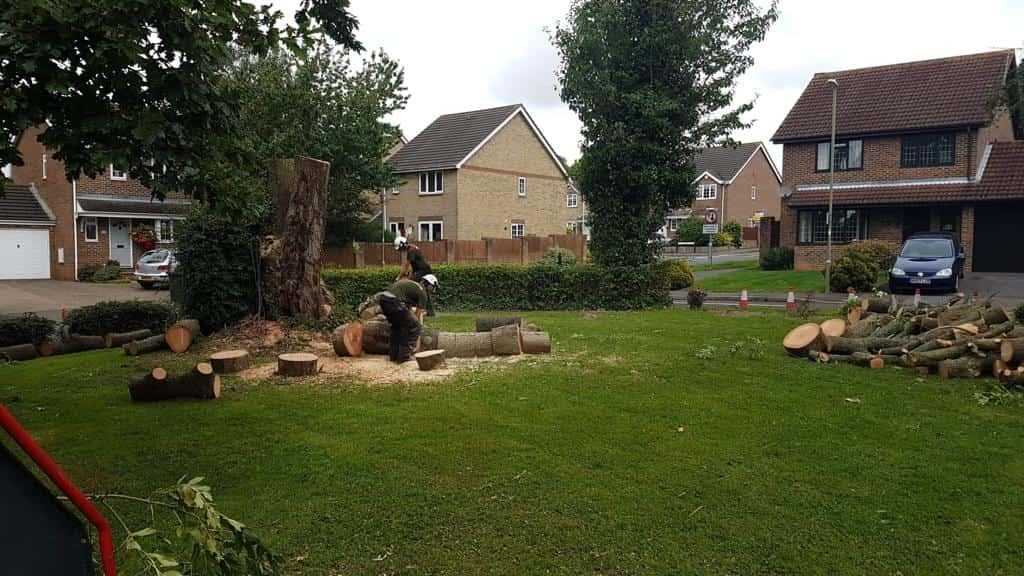Introduction
It’s easy to overlook the mature tree standing proudly at the edge of your driveway. Perhaps it’s been there longer than your house, and over the years it’s become part of the landscape—something you pass daily without a second thought. But have you ever stopped to consider how safe it really is?
In Harlow and throughout Essex, we’ve seen how driveways bordered by old or poorly maintained trees can pose real risks to people, vehicles, and property. From falling branches to hidden root damage, there’s often more going on beneath the bark than meets the eye. In this article, we’ll break down the subtle (and not-so-subtle) signs your tree may be a hazard—and what you can do about it.
Key Takeaways
- Overhanging branches can pose a risk to parked cars and footpaths.
- Visible cracks or cavities in the trunk may signal internal weakness.
- Root damage often affects driveways and underground utilities.
- Leaning or shifting trees may be unstable and require assessment.
- Early leaf loss or decay might indicate disease or poor health.
- Ignoring tree issues can lead to costly damage or emergency removal.
- Professional evaluation offers peace of mind and proactive solutions.
Why Tree Safety Matters in Driveways
Driveway trees aren’t just decorative—they’re located where people walk, cars park, and children play. When a tree is structurally compromised, the risk extends beyond falling branches. We’ve seen cases in Harlow where entire driveways have been lifted or cracked due to aggressive root systems, or where decay wasn’t noticed until a sudden windstorm brought the tree crashing down.
It’s not just about avoiding an accident. Regular assessments by a professional tree surgeon can prevent long-term property damage and help retain the health of the tree. An unsafe tree isn’t just a hazard—it’s a ticking time bomb for your home, vehicles, and the people who visit.
Common Signs of a Dangerous Driveway Tree
You don’t need to be an arborist to spot warning signs. Keep an eye out for:
- Cracks or splits in the trunk or major limbs
- Large, dead or hanging branches over vehicles or pathways
- Fungal growth around the base of the tree
- Uplifted or cracked paving near the trunk
- Bark falling off or visible insect damage
- Leaning trunk or soil movement at the base
Each of these signs could point to deeper structural or health issues, many of which worsen over time. If caught early, a tree surgeon can often carry out targeted pruning, root management, or other interventions to restore safety without full removal.
The Hidden Dangers of Tree Roots
Roots don’t stop at the drip line (the edge of the tree’s canopy). In fact, they often extend far beyond it, seeking water and nutrients underground. When trees are planted close to driveways, roots can lift paving, crack tarmac, and interfere with drainage or underground cables.
Even more subtly, root damage can destabilise a tree. If a significant portion of a root system has been compromised—by nearby construction, compacted soil, or age—the entire tree may be at risk of falling. That’s why a professional inspection from Harlow Tree Surgeons focuses not just on what’s above ground, but below it too.
What a Professional Tree Inspection Includes
When we visit properties in Harlow and the surrounding Essex area, we conduct a thorough safety check of any tree in question. Here’s what we typically assess:
- Structural integrity of the trunk and major branches
- Signs of disease or decay, such as fungi or deadwood
- Root stability, including any visible heaving or cracking
- Surrounding environment, including driveway condition and proximity to buildings
- Canopy balance, which affects how a tree handles strong winds
The outcome may range from minor pruning to reduce risk, to recommending a staged removal if the tree is too compromised. Our goal is always to preserve healthy trees where possible and offer proactive solutions to keep you safe.
Prevention is Always Better Than Cure
Tree issues rarely resolve themselves. Over time, what starts as a small crack or a bit of leaning can evolve into something much more serious. Especially in high-traffic areas like driveways, being reactive could mean damage to your car, your home—or worse.
Here’s what you can do to stay ahead:
- Schedule regular tree health inspections
- Prune back overhanging branches professionally
- Avoid paving too close to the trunk
- Be alert to sudden changes in appearance or structure
A well-maintained tree adds charm, shade, and value. A neglected one can do just the opposite. If you’re unsure about a tree near your driveway, it’s worth getting an expert opinion sooner rather than later.
Conclusion
Your driveway is one of the most used spaces on your property, and any tree near it deserves close attention. What may seem like a harmless old oak or a shady sycamore could be hiding structural problems, disease, or root issues that only a professional can accurately assess.
At Harlow Tree Surgeons, we understand the unique challenges posed by urban and suburban trees in Essex. We offer expert inspections, honest advice, and reliable solutions that prioritise safety, tree health, and your peace of mind. So, the next time you reverse into your driveway, ask yourself—how safe is that tree? And if the answer isn’t clear, you know who to call.
Call us on: 01279 969 199
Click here to find out more about Harlow Tree Surgeons
Click here to complete our contact form and see how we can help with your tree care needs.

